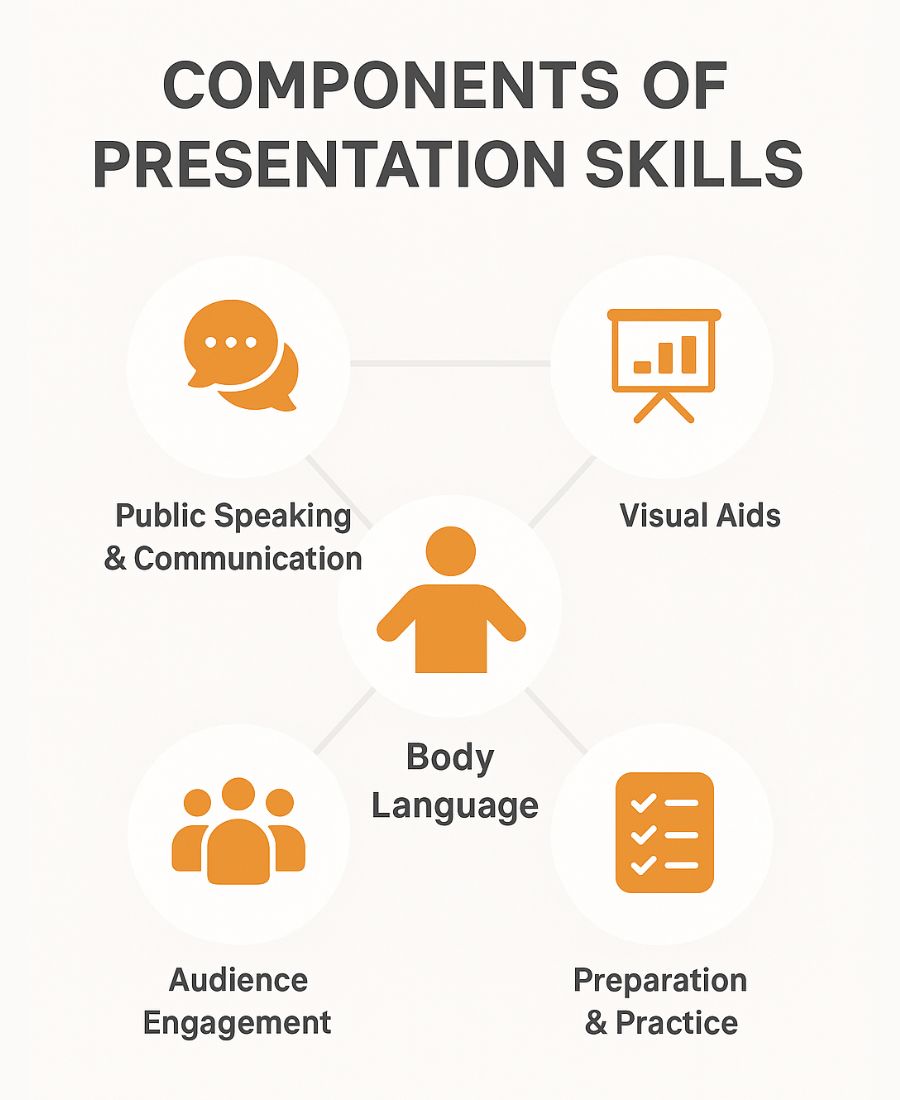



Presentation skills shape how others understand and respond to your ideas. They show clarity, preparation, and confidence; qualities that help you connect with your audience and hold their attention. By improving how you speak, move, and use supporting visuals, you can communicate messages that feel natural and credible. This article explains what presentation skills are, why they matter, and how to strengthen them for lasting impact.
When you talk about presentation skills, you're talking about the skills that help you get your ideas, facts, or tales over to an audience. These skills include more than just speaking out loud. They also include clear communication, confident delivery, and non-verbal skills including body language and eye contact.
The basics of presentation abilities are being clear, organized, and flexible. A businessperson might employ data-driven visualizations, while a teacher might use stories. Both want to keep their audience interested and connected.
Getting better at these abilities makes you more confident and trustworthy. You can affect decisions, motivate action, and leave a lasting impression with good presentation abilities. This process includes structuring your information, practicing how to give it, and responding to comments from the audience.
Presentation skills are important because they can change how others hear and remember your thoughts. Good presenters can capture people's attention, make complicated ideas easier to understand, and motivate them to act. These skills affect your work success, self-confidence, and credibility, not just public speaking.
At work, effective presentation skills can determine whether you receive attention or not. They help you clearly present ideas, make convincing recommendations, and run meetings with confidence. For jobs that include dealing with clients, a polished delivery can help you get business and build stronger professional relationships. When you show confidence and clarity, people will trust you.
Getting better at giving presentations makes you feel more confident in more than just formal situations. When you can express your thoughts properly, it makes you less nervous about speaking in front of other people. This confidence grows with time and makes it simpler to talk to people in both social and professional contexts.
How you act affects how other people see you. A well-organized and interesting presentation makes you look trustworthy, professional, and powerful. If you don't deliver your ideas well, others may not listen to them. You can persuade, inspire, and make a lasting impression better if you learn how to give a powerful presentation.

There are several parts that make up presentation abilities, and they all work together to get a message across clearly. By paying attention to these parts, you can turn a straightforward discussion into an interesting and unforgettable event.
Clear communication is the most important part of any presentation. If you can speak in front of a group, you can ensure your message is clear, timely, and suitable for the audience. This means picking the proper tone, changing the wording for different audiences, and getting rid of jargon that isn't needed.
Non-verbal communication plays a critical role in how your presentation is received. Open posture, purposeful gestures, and consistent eye contact create trust and engagement. Poor body language, like avoiding eye contact or crossing arms, can distract and reduce credibility.
Slides, charts, and videos can help people understand complicated information better. Visual aids can help get your point across and help people remember important things when they are used correctly. The most important thing is to find a balance. Your slides should help you communicate your message, not take away from it.
People keep listening because they are engaged. Asking questions, adding interactive aspects, or telling stories that people can relate to all help make the experience two-way. People are more likely to remember your message when they feel like they are a part of it.
Careful planning is what makes any polished presenter. Doing research on your topic, thinking about what questions people might ask, and practicing several times will help you feel less anxious and give a better presentation. The key to good presentation abilities is to practice them regularly.
When the core components of presentation skills come together, the result is a talk that feels clear, confident, and engaging. To know what makes a good presentation, you need to know what makes your delivery stand out and work well.
Strong presentations are built on clear organization. An engaging introduction sets the stage, the body develops the main points, and a memorable conclusion reinforces the key message. Without structure, even great ideas can get lost.
People respond well to presenters who look calm and sure of themselves. Steady eye contact, a calm voice, and calm body language all suggest that you are confident. Even if you're nervous, being ready and practicing will help you deliver with confidence.
A good presentation focuses on what the audience values. Tailoring content to their needs and interests increases engagement and ensures the message feels meaningful. The most skilled presenters prioritize connection over performance.
Slides, pictures, and charts that are well-designed can make a point, but they should not take the place of what you say. Your message will be stronger and easier to remember if you use short pictures and detailed explanations together.
You may turn a presentation into an experience by asking questions, getting people involved, and employing narrative approaches. This conversation gets people to pay attention and makes them feel more comfortable with you.
In short, strong presentation skills include being prepared, being able to change, and being real. It's not about being perfect in a good presentation; it's about getting your audience to comprehend, connect, and act.

Here are the steps for presentation skills that every presenter should know:
Knowing the theory of presentation skills is one thing. Putting them into practice is what separates an average talk from a memorable one. If you are wondering how to give a good presentation, the key is to focus on delivery, engagement, and preparation.

Once you understand the basic steps of building a presentation, the next challenge is refining your delivery. These advanced tips to improve presentation skills will help you move beyond the fundamentals and present with confidence in any setting.
There are many ways to strengthen your presentation skills, from structured courses to helpful tools. Here are some of the best resources to explore:
The importance of presentation skills comes from the fact that they can change how people hear, remember, and act on your message. When selling a concept in the boardroom, teaching in the classroom, or speaking at a public event, strong presenters use clarity, structure, and confidence to leave a lasting impression. Anyone may go from giving information to inspiring action if they practice often and use the correct methods.
Learning how to give a good presentation will help you for the rest of your life. You can get better at speaking and feel more confident by taking classes, practicing often, and using tools like a teleprompter software. You will quickly discover how effective presentation skills may help you in both your career and your personal life if you start working on them immediately.
Start using Teleprompter.com and deliver presentations with confidence every time.
Presentation skills are the abilities that help you share ideas clearly and confidently with an audience. They include public speaking, body language, storytelling, and the use of visual aids.
The five steps are: knowing your audience, structuring your content, practicing delivery, using body language and visual aids, and managing nerves while presenting.
To give a good presentation, focus on clarity, keep your structure simple, engage your audience, and present with confidence. Practice and preparation are key.
A good presentation is clear, engaging, relevant to the audience, and supported by effective visuals. Confidence and authenticity also play a major role.
You can improve by practicing regularly, seeking feedback, joining presentation skills training courses, and using tools such as a teleprompter app to refine delivery.



